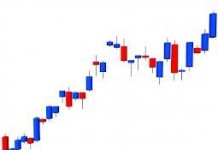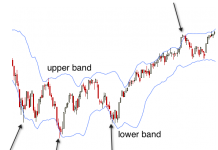Okay, so you’ve done your research, signed up and had a play with a demo account; you’ve gotten to grips with your broker’s trading platform, made some in-the-money trades, some out-of-the-money trades, but what now? Well at some point in your education as a trader you’ll probably want to start learning about technical indicators. Yes they seem forbidding, yes you can probably get by perfectly well using only fundamentals, but a complete trader has all the bases covered, so it’s definitely worth your while to at least be aware of what technical indicators are and how they work. This article is designed to provide a very basic overview, and to be a useful starting point if you would like to go on and find out more. When fellow traders talk about stochastic oscillators, Bollinger bands, and all manner of seemingly impenetrable acronyms (SMA , RSI, etc), do your eyes glaze over? Do you find yourself retreating to that happy place in the back of your mind? Well then this article is for you. Read on.
All jokes aside, a basic grasp of technical analysis will stand you in good stead as it helps you develop certain core trading skills that are applicable in all markets and across all assets. Essentially technical indicators are mathematical tools that use the historical performance of an asset in order to determine possible future trends. Technical analysis is the use of these tools as an aid to interpreting the market. You will have come across articles claiming that you are either a fundamental trader (meaning you trade on news and economic data releases) or a technical trader (meaning you trade on technical indicators). While there are some technical analysts who have no idea about fundamentals and believe that they don’t need to, for our purposes it is a false division. Most traders will use aspects of both types of analysis, and indeed in some instances each is suited to confirming the findings of the other.
In technical analysis the underlying suppositions are that:
- A. The price of an asset reflects everything you need to know about the company/market/country in question
- B. Prices move according to trends
- C. History repeats itself.
While fundamental analysis focuses on external factors (news, geopolitics, sentiment), technical analysis only cares about internal factors such as price and prior performance.
When using a technical indicator, an additional chart appears under the asset you are monitoring, the purpose of this is for you to be able to compare the current market conditions with the findings of the technical indicator you are using.
There are four basic types of indicators, they interpret the following: trend (an asset’s upward or downward movements), momentum (the speed at which an asset’s price increases, volatility (the degree to which an asset’s price refuses to follow a trend) and volume (the amount of trading activity on a particular asset). Below is a list of popular indicators and which of the four categories they belong to.
Trend: Moving Averages, MACD, Parabolic SAR
Momentum: Stochastics, CCI, Relative Strength Index (RSI)
Volatility: Bollinger Bands, Average True Range, Standard Deviation
Volume: Chaikin Oscillator, OBV, Rate of Change (ROCV)
Avoid Multicollinearity:
Multicowhat you say? This is the major issue with using technical indicators and it is one of the first mistakes that beginners make. Essentially multicollinearity is when the same kind of information is factored more than once, thus skewing results to make it appear more important than it actually is. This generally occurs when the same kinds of technical indicators are applied to the same chart. In order to avoid issues with redundant data it is best to avoid using more than one indicator from the same category on any one asset’s chart. The way to use more than one indicator is to select two that compliment each other. For example stochastic oscillators and a simple moving averages (SMA) are complementary indicators that provide more data when used in conjunction than alone.
Beginner’s Tips:
When you start practising with technical indicators keep things as simple as possible. Pick a single asset and apply no more than two technical indicators to it. Monitor its price movement and practice trend-spotting and forecasting future movement at a variety of time scales. When you have this down begin tweaking the parameters of the indicators you are using. Most charting platforms will allow you to vary things like the look-back period (how far back into an asset’s history the process will go) and other aspects of price data, tailor these to your needs as you become ore proficient at using them.
Finally:
Remember that indicators are not the same as strategies. Used alone they are insufficient, but as part of a robust trading and money management strategy they can be very useful tools. Also remember that they are not fool proof and are not the same as trading signals even though they help generate them. Technical indicators provide added resolution, revealing information about the asset you are trading on that may not be immediately clear by just observing its current price fluctuations.

















